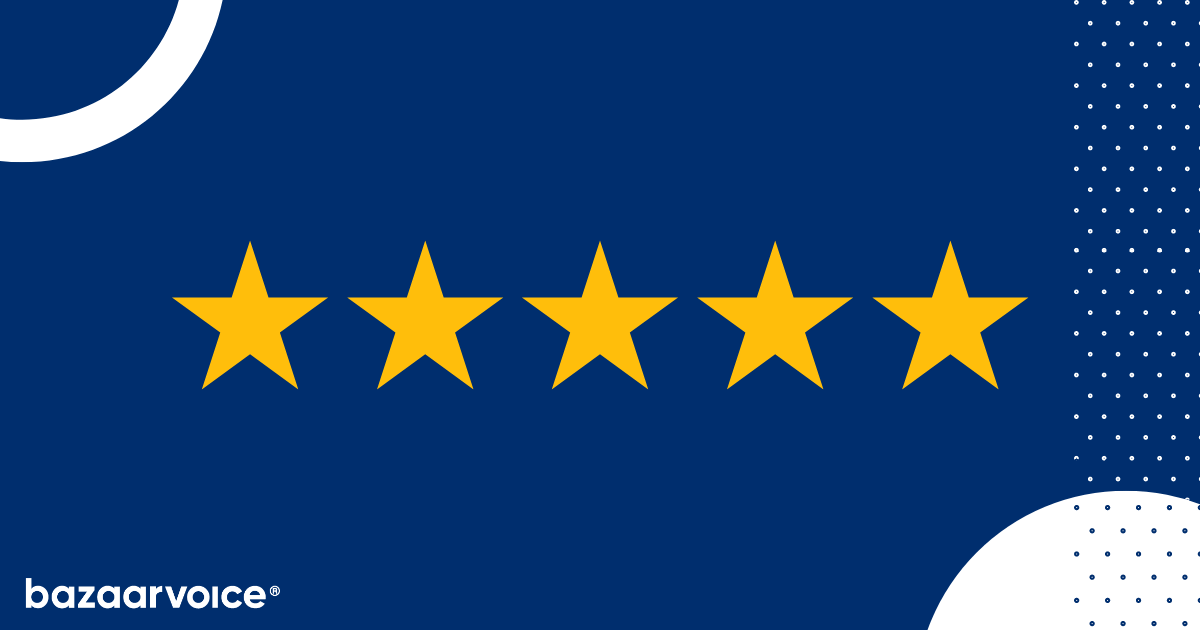December 18, 2023
We all know ratings and reviews are important. While they’ve only been around for about two decades, it’s hard to imagine shopping without them, especially if it’s our first experience with a brand. According to consumer research we conducted on 30,000+ global shoppers, the majority (88%) use reviews to discover and evaluate products.
From food and beverage and apparel to health and beauty and hardware to everything in between, ratings and reviews play a crucial role in the customer journey.
But just how crucial, exactly? And how can businesses extract the most value from them? Let’s find out.
The business benefits of ratings and reviews
At Bazaarvoice, ratings and reviews are the center of our business. With a network of over 12,500 brand and retailer sites to support, we undertake a lot of research to understand the value of reviews for businesses and their customers.
Here are some of our takeaways that prove the power of ratings and reviews, based on some of our latest research.
Ratings and reviews impact everything from sales to SEO
Shoppers are leaving more reviews now than ever. Across our network in 2021, the number of reviews submitted increased nearly 11% year-over-year. Our 2023 Shopper Experience Index found that when shoppers engaged with reviews, there was a 144% lift in conversion rate.
Not only are shoppers converting more readily on pages with reviews, but they’re also spending more money. The lift in revenue per visitor among shoppers engaging with reviews was 162% in 2023, and the average order value was 13% higher.
Ratings and reviews creates a great avenue for us to get current content on our site and bring attention to our product. That helps us to rank higher in search results and get found better
UX analyst, CPG
Increasing your sales and profits isn’t the only thing that reviews can improve in your business. Brands and retailers we’ve talked to say that reviews have an impact far beyond the product page. According to those we surveyed for our Shopper Experience Index, over half (52%) said they help increase brand loyalty, 53% cited a positive impact on in-store sales, and 63% said that they improve search engine optimization (SEO).
Global brand Petco, for example, launched a sampling campaign to collect more reviews and improve SEO metrics. The campaign led to a 405% increase in review volume, which meant a:
- 67% increase in number of pages ranked organically
- 140% increase in impressions from organic search
- 80% increase in clicks from organic search
- 48% increase in revenue per visit for sampled products
Ratings and reviews help shoppers make confident purchases
According to our 2023 Shopper Experience Index, two-thirds of consumers (78%) claim that reviews impact their purchase decisions. Our 2022 report also revealed that ratings and reviews are the number one online feature shoppers rely on when making informed product decisions faster, more so than product page descriptions, chatbots, and the website’s search tool.
But consumers aren’t just using them online. According to research commissioned by Bazaarvoice from Deloitte and Touche LLP, a vast majority (82%) of shoppers research products online before going in-store, and over a third read a product’s reviews on their mobile phones while looking at the same product in-store.
Our research found that shoppers often turn to ratings and reviews when they’re in the final stages of their decision making process to help them choose your product. 70% of shoppers often or always look at available reviews, and in the first 20 seconds of landing on a product page, high-quality reviews are the most likely type of user-generated content to convince a consumer to buy a product (21%) — followed by average star ratings (19%) and the number of reviews a product has (13%).
We also found that half of shoppers have been influenced by reviews to buy a more expensive product than planned.
You may be surprised to learn that it isn’t just positive reviews that consumers find helpful. Over half (60%) say negative reviews are just as important in their decision to buy. The majority (62%) say it’s because they contain more pros and cons than positive reviews. Shoppers who usually don’t read reviews say they would like to see more reviews from people like them and more customer photos.
Having reviews displayed on your site is a great first step to winning over your customers, but don’t forget step two — responding to reviews. About a third of shoppers expect businesses to publicly respond to their reviews, regardless of whether their review is positive or negative. Almost half (48%) say brands responding to reviews improves their odds of buying the product.
Reviews improve your brand’s authenticity
Brand trust is one of the most valuable assets a business can have in today’s retail landscape. According to our recent survey of 10,000 global shoppers, 97% of respondents say fake reviews make them lose trust in a brand. One way to build trust is by handing over the mic to their fellow peers to help advocate for your brand. Over three-quarters of shoppers trust reviews, even more than family and friend recommendations.
It’s not as simple as just displaying reviews, you have to ensure that they’re authentic. If shoppers suspect a product to have fake reviews:
- 56% wouldn’t buy the product
- 25% wouldn’t buy from the website
- 81% avoid using the brand again
- 48% leave a negative review
- 16% post [negatively] about the brand on social media
The number one factor that makes consumers suspicious that a product has fake reviews is seeing multiple reviews with similar wording (56%). That is followed by review content not matching the product (53%), bad grammar/misspellings (36%), and an overwhelming amount of positive/five-star reviews (36%).
As consumers have become more skeptical of marketing and advertising practices as a whole, they’re constantly evaluating product reviews to look for red flags.
Reviews contain insights about products, processes, and purchasers
Ratings and reviews are an invaluable source of customer feedback. Consumer reviews can help surface issues with products, shed light on new use cases, and inform product innovations. Shoppers want to see businesses use their reviews, both positive (25%) and negative (38%), to make product improvements.
We have countless stories from our clients about ways they have improved their products and processes based on the feedback they’ve received from customer reviews. In fact, 72% of our clients use UGC to improve customer service, 66% use UGC to improve products, and 50% use UGC to improve marketing tactics and messaging.
How to make customer ratings and reviews work harder for you
While impressive, these results won’t manifest out of thin air. The real magic happens when you set in motion a process to collect, distribute, and manage reviews, designed to squeeze the most value out of these pieces of UGC.
Set up a review collection strategy
In order to reap the benefits, you need to plant the seeds — in other words, you need an ongoing strategy that makes it easy for and encourages customers to share feedback about your products.
You can request ratings and reviews from your customers through a myriad of channels. If you have a physical store, you can go the face-to-face route and have attendants ask shoppers for feedback after they complete a purchase. The attendant can jot down the answers or direct the customer toward a QR code for an even smoother experience.
Online options are also aplenty. Review request emails are a common practice (Jeanswest saw a 186% lift in review volume using this strategy, for example), but social media channels, push notifications, and SMS texts are also viable approaches.
When requesting reviews through any of these channels, timing is key. Reach out soon after customers interact with your products, when the experience is fresh on their minds, and they can provide more detailed and genuine feedback. And how you ask is just as important as when you ask — use clear and concise messaging, and avoid overwhelming customers with too many requests or specific instructions.
Provide incentives in exchange for ratings and reviews
Customers might need a little extra push to share their feedback about your products. This is where incentivized reviews come in: you give customers a reward, like a coupon or entry into a giveaway, and in exchange, they write an honest review about a product they bought from your company.
Incentives can be small, like discount codes, or slightly more elaborate, like product sampling campaigns (offering samples of your product in exchange for reviews.) McPherson’s Consumer Products, for example, found that 20% of new reviews on its brands’ products come from sampling efforts. According to Sharon Bottaro, the company’s Head of Digital, these reviews, “are providing confidence for people to complete their path to purchase.”
To uphold your integrity and safeguard consumer trust, be transparent about your incentive program. Clearly state that the incentive is for leaving a review, regardless of whether it’s positive or negative, and never pay customers to leave reviews.
Encourage customers to add visual UGC
It’s a visual-driven world out there, especially in the e-commerce industry. Images and videos from customers give shoppers a better sense of what the products look like in action, and, most importantly, in the real world, without the influence of heavy editing. It adds another layer of confidence to purchasing decisions, which explains why 29% of shoppers look for customer reviews with photos or videos.
Fresh, a cosmetics company known for its natural ingredients-based products, tapped into the power of visual UGC in customer reviews. The brand implemented Bazaarvoice’s Photo-First Reviews Display to put customer images and videos front and center of product pages. Overall, Fresh saw a $1.48 million impact from user-generated content.
When requesting reviews from customers, whether through an email or a sampling campaign, make sure you ask for visuals — people might even prefer filming a short video over writing a lengthy review! Don’t make it a non-negotiable (a written review with no visuals is better than no review), but let customers know images and videos are appreciated options.
Reply to both positive and negative reviews
Customers expect brands to engage with them when they take the time to leave a review, especially if it’s negative. As Anna Kim, Senior Advocate Programs Manager at Webroot, explains, “It’s our responsibility (…) to be responsive to shoppers’ questions and reviews. Someone who is vetting us against another brand sees that we interact with our customers, and that’s a big competitive advantage.”
Webroot practices what it preaches — the cybersecurity software company replied to 70% of its 38,000 customer reviews on retail sites.
When responding to positive reviews, gratitude is the name of the game. Thank the customer for sharing their opinion, and express happiness that they enjoyed the product. Reference specific points mentioned in the review to make your response more personal and show that you value their input.
Negative reviews are a different beast, but they don’t have to be a scary one. As we explained before, having some negative reviews contributes to authenticity, and they can be a good way to unveil problems you weren’t aware of. What you shouldn’t do is ignore them; instead, act quickly, acknowledge the customer’s experience, and offer a solution to the issue raised in the review. If the problem is too complex, invite them to continue the conversation through a private channel like email or phone.
Amplify ratings and reviews with syndication
If your brand works with retail partners to sell its products, syndicating reviews to their websites is a must. There’s no guarantee consumers will find and buy your products on your own website — syndication gets consumer eyes on your product reviews whether they’re browsing Walmart or Target.
This strategy also benefits your retail partners since they get quality, conversion-optimized content on their product pages without having to invest in technology to do so.
Bazaarvoice has a network of 1,750 global retailers, and regularly helps brands syndicate their hard-won customer reviews to as many partners as possible. For Andi-Co, 100% of reviews on retailers’ sites come from Bazaarvoice syndication efforts, leading to 690x more UGC on retailer sites.
Make ratings and reviews a part of your marketing strategy
Displaying reviews on your website is a no-brainer, but why stop there? Incorporating reviews into your offline and digital marketing can significantly enhance its effectiveness — according to our 2022 Shopper Index, almost half (40%) of consumers say UGC makes them more likely to buy a product from an ad. Beyond product pages, here’s where you might consider displaying this rich UGC:
- Social media channels like Instagram, Facebook, and TikTok. Social commerce continues to grow as social becomes the new search — over half (58%) of shoppers say they often discover a product or service through social media, and 42% say social media impacts their purchasing decisions. Adding reviews to your posts both amplifies positive content and gets the conversion machine that is user-generated content in front of an audience that’s primed to discover and buy new products
- In-store displays. If you have a brick-and-mortar presence, display reviews and ratings near relevant products to bridge the gap between online and offline experiences and nudge shoppers toward making a purchase
- Emails. Use positive reviews in your email marketing campaigns. For example, when promoting a product, include a customer testimonial that speaks to its benefits. Tailor your emails based on the products customers have purchased and include reviews from similar products to encourage repeat purchases, cross-sells, and up-sells
Don’t underestimate how important ratings and reviews are for your business
While some might think it’s difficult to quantify the importance of ratings and reviews, the above statistics prove their power.
There’s a variety of ways that they are useful, both for businesses and their customers. And not only are ratings and reviews absolutely necessary to today’s consumers during the purchasing process, companies are missing out on sales, profits, and priceless information without them, as our own research below shows.
Learn more about how important ratings and reviews are here. Or get in touch directly below to see how you can get started with Bazaarvoice Ratings & Reviews.
Get started









